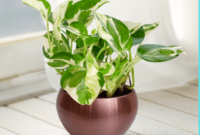Money Grows on Trees: Discovering the World’s Wealthiest Flora
Money is an essential aspect of our lives. We need it to buy basic necessities, pay bills, and fulfill our desires. However, have you ever wondered where money comes from? Yes, we all know that we earn it from our jobs, but where does the money we use come from? Interestingly, money, in its physical form, is printed and minted by the government, but the material used in making it comes from nature.

Indeed, money grows on trees! The world’s wealthiest flora includes several plant species that have significant economic importance. These plants have been used for centuries as a means of exchange, trade, and commerce.
One of the most well-known money plants is the rubber tree. This tree species is native to the Amazon rainforest and is cultivated in several parts of the world, including Southeast Asia. The rubber tree produces latex, which is used to make rubber. Rubber is used to make several items, including car tires, rubber bands, and even erasers. The rubber industry generates billions of dollars in revenue annually, thus making the rubber tree one of the wealthiest flora species globally.
Another plant species that has economic significance is the cocoa tree. Cocoa is used to make chocolate, which is enjoyed by millions worldwide. The cocoa industry is a lucrative business, with global sales estimated at over $100 billion annually. The cocoa tree is native to Central and South America but is now cultivated in several parts of the world, including Africa and Southeast Asia.
The tea plant is another money plant that has significant economic importance. Tea is the world’s most consumed beverage after water, with over 2.16 billion cups consumed daily. The tea industry generates billions of dollars in revenue annually, and the tea plant is now grown in several parts of the world, including India, China, and Kenya.
The coffee plant is another money plant that has significant economic value. Coffee is the most consumed beverage after water and is grown in several parts of the world, including South America, Africa, and Southeast Asia. The coffee industry generates billions of dollars in revenue annually and provides employment to millions worldwide.
The cotton plant is another money plant that has economic significance. Cotton is used to make clothing, bed sheets, and several other items. The cotton industry generates billions of dollars in revenue annually, and cotton is cultivated in several parts of the world, including the United States, China, and India.
Lastly, the oil palm tree is a money plant that has significant economic value. The oil palm tree produces oil, which is used in several industries, including food, cosmetics, and biofuels. The oil palm industry generates billions of dollars in revenue annually and provides employment to millions of people worldwide.
In conclusion, money does indeed grow on trees! Several plant species have significant economic importance and generate billions of dollars in revenue annually. These money plants have been used for centuries as a means of exchange, trade, and commerce. As we explore the diverse money plant species across the globe, we can appreciate the natural resources that have enabled us to progress as a society.
From Leaves to Coins: A Tour of the money plant Kingdom
When we think of money, we often imagine stacks of cash, shiny gold coins, and precious gems. However, did you know that there are plants around the world that are known as money plants? These plants have been associated with good luck, prosperity, and wealth for centuries, and many cultures believe that they bring financial success to those who grow them. Join us as we take a tour of the fascinating money plant kingdom and explore the different types of plants that can help you grow your wealth.
1. Jade plant
The jade plant, also known as the money tree or friendship tree, is an evergreen succulent native to South Africa. It is believed to bring financial prosperity and good luck to its owner, making it a popular gift for businesses and new homeowners. The plant has thick, round leaves that resemble coins, and it is said that the more leaves it has, the greater the wealth it will attract.
2. Chinese money plant
The Chinese money plant, also called the Pilea peperomioides, is a native of China and is known for its distinctive round leaves that resemble coins. It is believed to bring good luck and fortune to its owner, and it was even used as a symbol of wealth in Ancient China. This plant has become very popular in recent years due to its easy care requirements and unique appearance.
3. Crassula ovata
The Crassula ovata, commonly known as the jade plant or money plant, is a succulent native to South Africa. It’s a popular choice for indoor gardens, and is believed to bring prosperity and good fortune to its owners. It has small, round leaves that are green in color, but can turn red or purple in certain lighting conditions.
4. Aloe vera
The Aloe vera plant is well known for its medicinal properties, but did you know that it is also considered a money plant? In some cultures, it is believed that growing an aloe vera plant in the home or office can bring financial success and good luck. This succulent plant is easy to care for and can thrive in a variety of conditions.
5. Marimo moss ball
The Marimo moss ball, also known as Aegagropila linnaei, is a type of moss that grows in ball form. It is native to Japan and is believed to bring good fortune and prosperity to those who keep it. The Marimo moss ball is unique in that it requires very little care, making it a popular choice for those who want to bring a little bit of nature into their home or office.
6. Basil
Basil is a well-known herb that is used in many different cuisines around the world. However, it is also considered a money plant in some cultures. It is believed that if you grow basil in your home or garden, it will attract wealth and prosperity. This fragrant herb is easy to grow and can be used fresh or dried in a variety of dishes.
7. Lucky bamboo
Lucky bamboo, also known as Dracaena sanderiana, is a popular indoor plant that is believed to bring good luck and prosperity to its owner. It is native to Africa and is often grown in small containers filled with water and rocks. Lucky bamboo is easy to care for and can be trained into different shapes, making it a fun and unique addition to any home or office.
In conclusion, these are just a few of the many plants around the world that are considered money plants. Whether you believe in their powers or not, there’s no denying that these plants are beautiful and can add a touch of nature to any space. So why not try growing one of these money plants and see if it brings a little bit of financial success your way?



